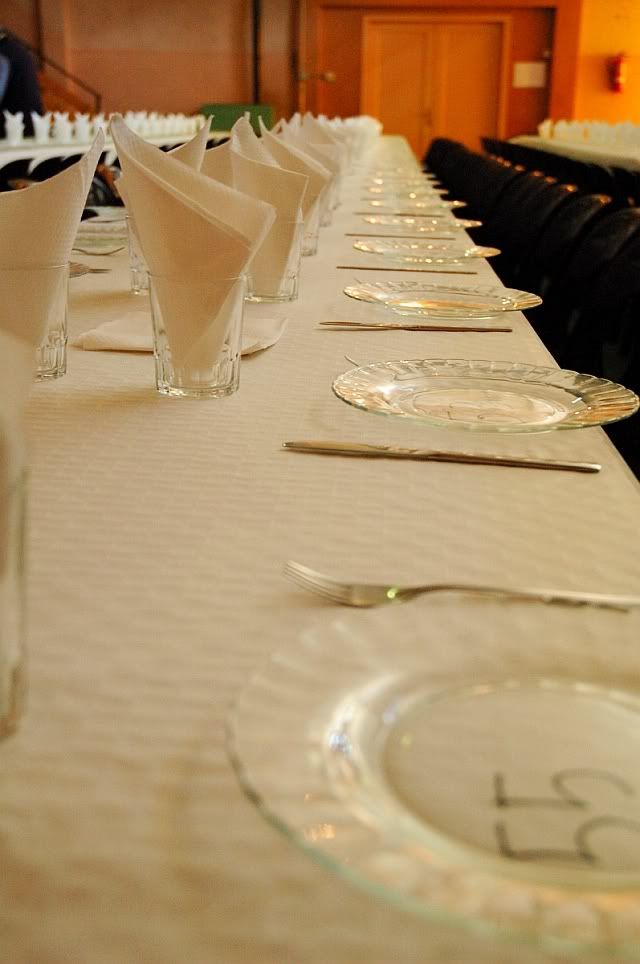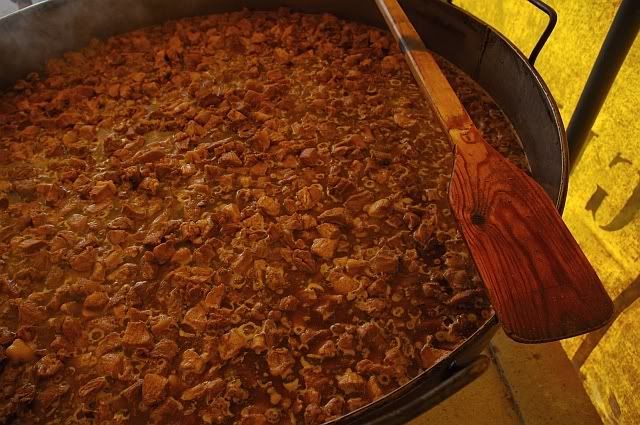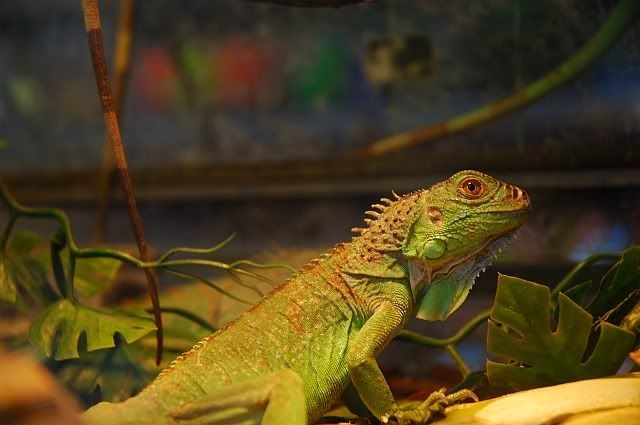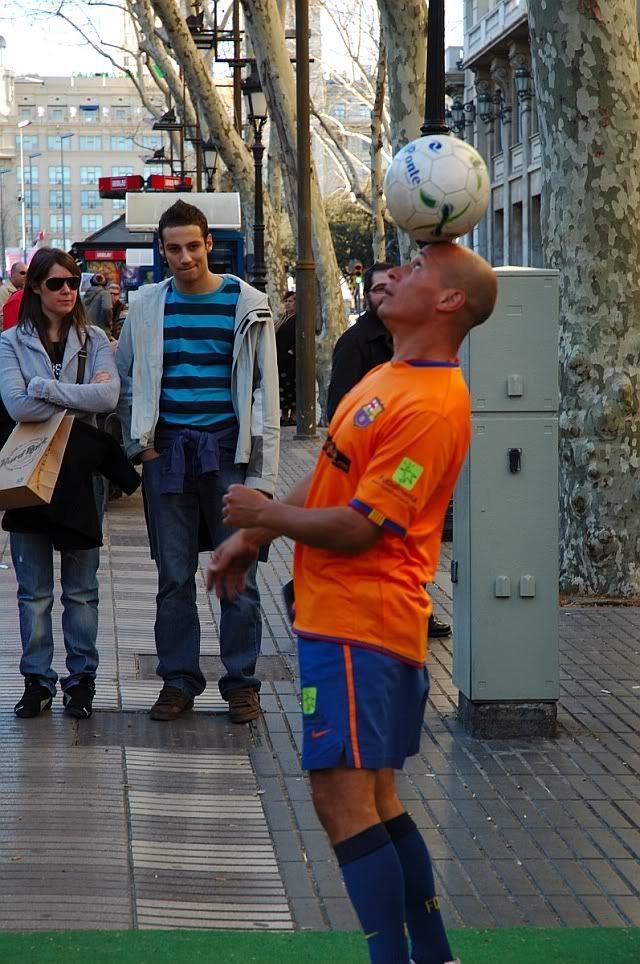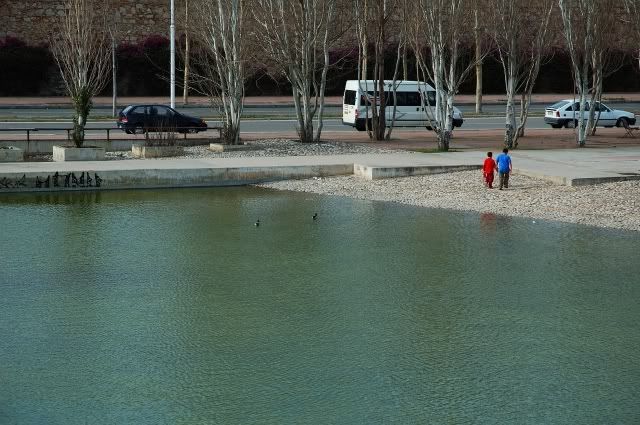Barcelona photos: Daily photographs of Barcelona, Spain. Pictures of a modern city with travel tips in a personal photoblog. A photography and travel site. Art, architecture, people and traditions. Travel to Barcelona through my camera, know more about our city and towns nearby. Welcome!
Wanna be featured?
June 08, 2008
June 07, 2008
Cherry Festival (Festa de la Cirera), Torrelles de Llobregat, Barcelona
![Cherry Festival (Festa de la Cirera), Torrelles de Llobregat, Barcelona [enlarge]](https://i63.photobucket.com/albums/h135/carloslorenzo/CherryFestival-TorrellesdeLlobregat.jpg)
With these cherries I would like to introduce you to the Festa de la Cirera (cherry festival and market) celebrated in Torrella de Llobregat this weekend. This small town from Xth c. is only some kilometers away from Barcelona city. In fact Torrelles is a municipality in the Baix Llobregat comarque on the right bank of Llobregat river (one of the two rivers surrounding Barcelona). I have some more pictures which I'll show you in coming posts. Check Torrelles de Llobregat on Google maps.
The annual cherry festival at Torrelles de Llobregat holds deep historical significance in the Catalan region. Dating back centuries, the tradition was born out of the area's fertile soil and ideal climate for cultivating cherries. Catalan cherry orchards have long been renowned for their exceptional quality and distinctive taste.
Over time, the festival has evolved into a cherished cultural event, serving as a platform to honor the centuries-old cherry-growing heritage. It has become a symbol of community pride, where locals come together to celebrate their agricultural traditions and pay homage to the land that sustains them.
The festival's roots can be traced to the age-old practice of organizing fairs to showcase the region's bountiful harvest. Torrelles de Llobregat, with its picturesque countryside dotted with cherry trees, became the perfect setting to host this annual gathering.
Through the centuries, the festival has witnessed the evolution of cherry cultivation techniques, the introduction of new varieties, and the advancement of cherry-related industries. Today, it stands as a testament to the resilience and passion of Catalan cherry growers who have preserved this cultural heritage through generations.
The annual cherry festival not only offers a delightful gastronomic experience but also serves as a living history book, reminding us of the traditions, skills, and dedication that have shaped Catalonia's renowned cherry industry.
June 06, 2008
Gerbera Daisy Close-up
This is what was left of a gerbera daisy or at least that's how I figure it is called. Some time ago I posted a similar picture and I was kindly given the right name. I think it was Heather who did it. Thanks again. If I am in a mistake today blame me! Of course my posts are not about taxonomy but beauty, my concept of beauty. Sometimes I am lucky to match yours and more than often I fail. That's the wonderful thing. The world would be very boring otherwise.
June 05, 2008
Barcelona Trees: Horse Chestnut or Conker Flowers
Aesculus hippocastanum or common horse chestnut can be seen in some parks of Barcelona so I thought you might like the image of its flowers. These I shot in Bellaterra in early spring. I suppose it must have yielded the characteristic spiny conkers by now. From the seeds of this tree a substance called saponin aescin is extracted and used for health purposes like treating varicose veins, edema, sprains. This constituent strengthens the blood vessels and prevents thrombosis. It has haemolytic properties and is recommended as an astringent and circulatory tonic. The extracts from horse chestnut are used to treat cellulitis. So you see, the beautiful tree and its flowers are not just an adornment. Talking about adornment. Did you know that the leaves of horse chestnut trees are a common pattern in art nouveau architecture? Well, follow this fantastic link and you'll find out more about the use of nature in the Art Nouveau decoration.
June 04, 2008
Centric Point Hostel: Passeig de Gracia 33, Barcelona, Spain

Not too long ago, I uploaded three pictures about hotels in Barcelona. I suggested they could be right although it was not an affirmation. After some thought I reckon that talking only about hotels wouldn't be fair with the hostel business or better yet with young people who want to enjoy Barcelona on a low budget.
I have to confess here that whenever I think of hostels many dark, shabby places come to my mind. Every city has scary hotels, motels or hostels. But you know cliches are not to be taken too seriously. The other day, I noticed a group of young boys and girls were having a chat on the corner of Passeig de Gracia and Consell de Cent. They had come out of a building with a big sign on the door that read: Centric Point Hostel. In fact this is nothing that calls your attention for more than two seconds. They were all blond, dressing casual and showing off that unmistakable white skin that's bound to be sunburnt the following day or is already as red as a boiling lobster's shell. They didn't look like the average backpacker though, and they seemed to be pretty happy talking there. All of that made me muse a little: "Hey, this hostel in the middle of Passeig de Gracia looks like a hotel!". On one of the balconies with some towels drying up in the sun (something unthinkable in this part of the city) I saw a girl leaning and looking towards the modernist buildings nearby and I realized how privileged she was of having such great view of the most frequented and elegant street of Barcelona. The cherry on top was that the building is modernist too and has been recently restored. I am sure there are lousy places to stay in Barcelona but this one is definitely not, you would say it's a like 3 star hotel!. So I decided to share a hostel post with you today starting with a good one, of course you definitely have to check other sources too.
Here is a list of places near Centric Point Hostel:
Las Ramblas (5 minutes walking), Catalunya square (3 minutes walking)and many art nouveau (Catalan modernisme) houses such as Gaudi's Casa Batlló (50 metres), Casa Amatller (45 metres), Gaudi's Casa Milá also known as La Pedrera (5 minutes walking) or Casa Lleo Morera (5 metres). I forgot to say that along Passeig de Gracia you have the best shops in town no wonder it is one of the most expensive streets in Barcelona and Spain but you don't need to worry about that too much as it is always easy to find cheaper places to shop around in the area. I also go downtown everyday and never buy an Armani you know.
Maybe you want me to recommend some other hostels so you can compare: Hostels and a map of hostels. Have a nice, cheap and comfortable stay in Barcelona!
June 03, 2008
National Theater of Catalonia
June 02, 2008
A Day at the Races
If you've visited a local fair maybe you are familiar with the usual horse race to fight for a wonderful teddy bear. We went to Port Aventura and I prayed for my daughter not to win the first price. She had never played before so the odds were little. Bulls***, she won an enormous banana, taller than me and we had to hold it all along the park so imagine how funny it should be.
June 01, 2008
Inside the Bubble, Bubblebou Show by Pep Bou

Another picture of the Bubblebou show created by Pep Bou.
This time the artist was inside the bubble blowing out to make the surface transform adopting funny shapes. The place, Port Aventura, the amusement park on the coast of Tarragona, one of the Catalan provinces near Barcelona.
May 31, 2008
Maori Warrior at Port Aventura Amusement Park, Salou, Spain
You know what maybe the tourist in last post was lucky after all. Maybe if you didn't dance dressed like that for the crowd you would receive severe punishment for such great dishonor and you would have to face this. The scary look and the menacing gestures of a maori warrior. Man, imagine landing on the beautiful island a long time ago and being approached by a group of such warriors performing the famous dance. Wow, now I know how it must feel before the rugby match.
May 30, 2008
Maori Girls Dancing With Guest in Port Aventura
This young man saved us all from being randomly chosen by these beautiful maori girls at Port Aventura Amusement Park in Salou, Spain. I mean, who hasn't dreamed of being on a desert island, surrounded by maori girls and all...but that doesn't mean you have to dress like a scarecrow for the joy of the crowd. Tourists!!!
May 29, 2008
Masks, The Mystery of Carnivals

This one has a halo of mystery and fantasy. I chose to leave it pretty dark to concentrate just on the masks. It is not carnival anymore but I forgot to post it when I had to. Never is too late for beauty though. Looking for more? Check more pictures of the Catalan Carnival in Barcelona:
May 28, 2008
Narrow Alley
May 27, 2008
May 26, 2008
Sausage Closeup
May 25, 2008
Small Lake in the Afternoon, Ivars, Lleida
May 24, 2008
Agbar Tower Distant View
May 23, 2008
May 22, 2008
May 21, 2008
May 20, 2008
May 19, 2008
Almond Flowers

Nature has gifted us with an abundance of breathtaking sights, and one such marvel is the delicate and enchanting almond flower. Almond trees, scientifically known as Prunus dulcis, belong to the Rosaceae family and are native to the Middle East and Mediterranean regions. These stunning blossoms announce the arrival of spring, transforming vast landscapes into beautiful tapestries of white and pink hues.
The almond tree's blossoming season is a magical time, typically occurring in late winter or early spring, before the emergence of leaves. As the winter chill gives way to the gentle warmth of the sun, the almond trees awaken from their dormant state. The flowers burst forth, adorning the branches with clusters of soft, fragrant petals. It is a sight that evokes a sense of joy and anticipation, symbolizing the rejuvenation and renewal of nature.
Almond flowers are small, measuring only about an inch in diameter, and possess a five-petal structure. These petals can vary in color, ranging from pure white to shades of pale pink. Each blossom showcases a vivid center, composed of a multitude of stamens and a single pistil. The stamens bear the pollen-producing anthers, while the pistil holds the ovary, which eventually develops into the almond fruit.
The scientific name of the almond flower is Prunus dulcis var. dulcis, and it is closely related to other members of the Prunus genus, including cherries, peaches, and plums. This shared lineage is evident in the similarities in their flower structure and the overall appearance of the trees.
Almond trees have a rich history and are deeply intertwined with the culture and heritage of many regions. One such place where almond trees hold a special significance is Catalonia. The gentle Mediterranean climate and fertile soils of Catalonia provide an ideal environment for almond cultivation, making it one of the prominent almond-producing regions in Europe.
The almond blossoms are not only visually stunning but also play a crucial role in the pollination process. Bees and other pollinators are drawn to their nectar and pollen, ensuring the cross-pollination necessary for the production of almonds.
The blossoming period of almond trees in Catalonia typically occurs between January and February, marking the arrival of spring. It is a time of celebration, and local communities often organize festivals and events to honor the beauty and significance of the almond flowers. Visitors can immerse themselves in the exciting atmosphere, enjoying traditional music, dances, and local delicacies made with almonds. For example, in many towns of Lleida numerous activities are organized around almond trees in bloom. Check this interesting blog with pictures at Les Garrigues, Lleida.
The next time you witness the gentle embrace of almond blossoms, take a moment to appreciate the intricate beauty and botanical marvels they represent.
May 18, 2008
May 17, 2008
May 16, 2008
Cirque du Soleil - Alegria

Alegria: A Mesmerizing Journey into the Enchanting World of Cirque du Soleil
Cirque du Soleil, renowned for its breathtaking acrobatics, stunning visuals, and awe-inspiring performances, has captivated audiences worldwide for decades. Among its many captivating shows, Alegria stands out as a timeless masterpiece that combines artistic prowess, theatrical storytelling, and unparalleled acrobatic feats.
In this article, we will delve into the magical world of Alegria and explore the mesmerizing experience that has enchanted audiences for years.
Unveiling Alegria:
Alegria, which means "joy" in Spanish, is a Cirque du Soleil production that made its debut in 1994. Created by director Franco Dragone, the show has been performed across the globe, captivating millions with its unique blend of circus arts, theater, and music. Alegria tells a captivating story that explores the human condition, the struggle between power and weakness, and the eternal quest for happiness.
Storyline and Themes:
Set in a whimsical, dreamlike universe, Alegria takes the audience on a journey through a fantastical realm inhabited by a cast of extraordinary characters. The show's narrative revolves around the character of the Innocent, who embarks on a quest for self-discovery and seeks to reclaim the essence of joy that has been lost in a world dominated by power and corruption. Throughout the performance, Alegria explores timeless themes such as love, power, transformation, and the triumph of the human spirit.
Acrobatics and Artistry:
At the heart of Alegria lies Cirque du Soleil's signature acrobatic prowess. The show features a remarkable ensemble of world-class performers, each exhibiting exceptional strength, agility, and precision. From breathtaking aerial acrobatics to gravity-defying contortionists, the artists push the boundaries of human capability, leaving audiences in a state of sheer wonder and amazement. Alegria's choreography seamlessly blends acrobatics with dance, creating a visually stunning display of artistry that leaves a lasting impression.
Spectacular Visuals and Soundscapes:
In true Cirque du Soleil fashion, Alegria boasts a mesmerizing visual spectacle. Elaborate costumes, vivid sets, and imaginative props transport the audience into a vibrant and surreal world. The show's design reflects a fusion of historical influences, contemporary aesthetics, and whimsical flair, immersing spectators in an otherworldly experience. Complementing the visual feast is a rich musical score composed by René Dupéré, featuring a mix of haunting melodies and high-energy rhythms that perfectly enhance the emotional depth of the performance.
Legacy and Impact:
Alegria's impact on the world of entertainment cannot be overstated. The show has been seen by millions of people across the globe, earning critical acclaim and numerous awards. Its success paved the way for Cirque du Soleil's continued evolution and expansion, firmly establishing the company as a trailblazer in the realm of circus arts and live performances. Alegria's timeless themes and artistic brilliance have resonated with audiences of all ages and backgrounds, leaving a lasting impression and a sense of joy that transcends cultural boundaries.
Alegria stands as a testament to the innovative and transformative power of Cirque du Soleil. Through its captivating story, awe-inspiring acrobatics, and spellbinding visuals, the show takes audiences on an enchanting journey that leaves them inspired, moved, and filled with a renewed sense of wonder. Alegria's enduring legacy serves as a reminder of the profound impact that art and creativity can have on our lives, inviting us to embrace the joy and magic that can be found in the extraordinary.
May 15, 2008
May 14, 2008
May 13, 2008
May 12, 2008
May 11, 2008
Sardana Dancers

May 10, 2008
Sardanas at Barcelona Cathedral
May 09, 2008
May 08, 2008
May 07, 2008
May 06, 2008
May 05, 2008
May 04, 2008
May 03, 2008
May 02, 2008
May 01, 2008
Tango Dancers II, Ramblas, Barcelona, Spain
I am not too talkative today and besides an image sometimes speaks for itself. You all know what tango is. I only have to say that you can watch dancers like this couple at Las Ramblas in Barcelona. By the way this is the second time they appear in my blog, see the previous snap which is very similar although less contrasty: Tango Dancers in Las Ramblas I
April 30, 2008
Holy Water Font or Basin Made With Shell, Colonia Guell's Crypt, Barcelona, Spain
![Holy Water Font or Basin Made With Shell, Colonia Guell's Crypt, Barcelona, Spain [enlarge]](https://i63.photobucket.com/albums/h135/carloslorenzo/Holy_Water_Font-Shell_.jpg)
Stationary fonts like this are placed at the entrance to churches as you all know but I am sure you never saw a holy water font made with an enormous shell nor have you seen perhaps such wonderful ironwork pedicle. Nothing is common and ordinary when you enter Gaudi's crypt at Colonia Guell. The place has columns, altar, stain glass and pews as any other church but you have to be prepared to digest the degree of variation of the holy elements. A church was supposed to be on top of the crypt, as the latter was part of a bigger project which started in 1908. In 1917 one year after Gaudi's art patron and friend, Eusebi Guell, died, the work was finally stopped. As you can guess foundations are very solid. Columns are made of basaltic rock and different kinds of bricks. The ceiling is vaulted in the most traditional gothic style. Every arch, every pillar, was precisely calculated with small sacks full of pellets which were tied to the ceiling in Gaudi's workshop by means of small pieces of cloth and string making up what is known as a stereostatic model. The weight of every sack was proportional to the load every arch element had to hold. But everything here is hard to imagine without visiting Colonia Güell of course. By the way, there were some posts in Barcelona Photoblog some time ago that might help: Caprice Supreme of Architecture, Modernist Door and Mosaic, Futurist Windows and Stained Glass
April 29, 2008
Colorful Bolivian Tinted Feather Hat, Moll de la Fusta, Barcelona, Spain
At Moll de la Fusta (Barcelona Port, Spain), there are these occasional parties organized by interracial non-profit agencies that we city dwellers tend to visit out of pure curiousity at first and enthusiastically once you get addicted to. There's the usual inexpensive exotic food offer which in many cases is the luring part of it believe me, at least for many people, let's not be hypocritical, and then there's the leisure side, particularly for parents who can't find a better place to take their kids that really satisfies them both and finally there's the integration side which originally was supposed to be the first one. At least this is the way I see it although "committed" citizens might openly disagree. Wouldn't it be better to give immigrants other kinds of opportunities rather than selling feather hats they don't wear anymore, I mean this is like selling tomahawks and rabbit paws. You have to say that the hat is beautiful and that unfortunately many people in the world have to sell traditions as if they were souvenirs for a living. I don't mean to be radical, of course, there are many color shades as in the hat.
April 28, 2008
Rambla de Mar Lightweight Bridge, Barcelona, Spain
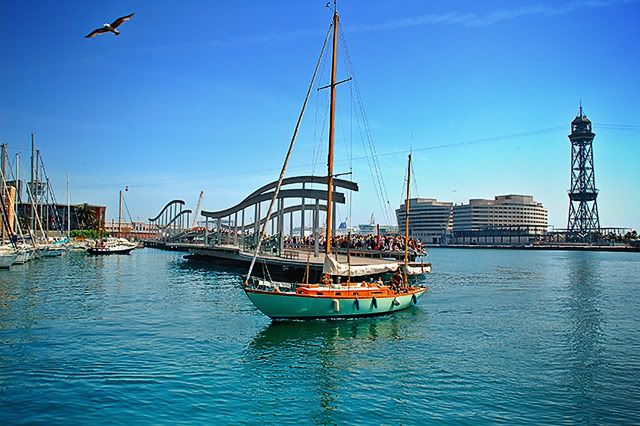
Witnessed by the anxious crowd gathering on the Rambla de Mar lightweight bridge close to Maremagnum shopping center, gently sails this boat, stopping time for some minutes and forcing visitors to enjoy the view longer than expected, till the mechanism in the bridge extends the wooden platform towards the pier on the other side. The bridge by Viaplana and Pinion leads to Las Ramblas nearby and was featured in Barcelona Photoblog in the past: Waiting for the Bridge at Rambla de Mar and Maremagnum Wooden Bridge in Rush Hours.
And just in case you would like to enjoy the same view daily here is list of Barcelona hotels near the port:
April 27, 2008
Can Can Girls at Far West Saloon, Port Aventura, Spain
After a long journey through all attractions in Port Aventura amusement park, the best way to rest is choosing one of the many shows available. The Far West area is for me one of the most complete and genuine. This is a picture I took in the saloon where these beautiful girls were dancing can can ("The can-can (also spelled cancan or Can Can) is regarded today primarily as a physically demanding music hall dance, performed by a chorus line of female dancers who wear costumes with long skirts, petticoats, and black stockings, harking back to the fashions of the 1890s. The main features of the dance are the lifting up and manipulation of the skirts, with high kicking and suggestive, provocative body movements. The cancan first appeared in the working-class ballrooms of Montparnasse in Paris in around 1830. It was a more lively version of the galop, a dance in quick 2/4 time, which often featured as the final figure in the quadrille. The cancan was, therefore, originally a dance for couples, who indulged in high kicks and other gestures with arms and legs. It is thought that they were influenced by the antics of a popular entertainer of the 1820s, Charles Mazurier, who was well known for his acrobatic performances, which included the grand écart or jump splits—later a popular feature of the cancan. At this time, and throughout most of the 19th century in France, the dance was also known as the chahut. Both words are French, cancan meaning "tittle-tattle" or "scandal", hence a scandalous dance, while chahut meant "noise" or "uproar"." Wikipedia). Suggestions: Try to finish your drink before the show ends cause the house is emptied so the next group of people standing in line comes in.
April 26, 2008
Cello Duet: A Close Look
Recently I went to see my daughter play the piano. She attends a music school called Tritó, one of the many small academies subordinate to the Municipal Conservatory of Music of Barcelona. Twice a year, students are supposed to play in front of an audience and seniors are sincerely worth listening to. In the picture, you can realize how near my chair was from the musicians, so close, these two cellos wouldn't fit completely in my viewfinder. Not that you haven't seen a cello before but it was curious to notice how aesthetic it is when both hands catch up in a similar position, both bows being parallel and all. The cello duet, made up of teacher and student, did quite well and we enjoyed some classical moment in an almost intimate atmosphere. To add some mood to the post, here is a cello video I came across on YouTube: Bach Cello Suite No1 i-Prelude.
April 25, 2008
The Bat in Colonia Guell At The Secretary's House
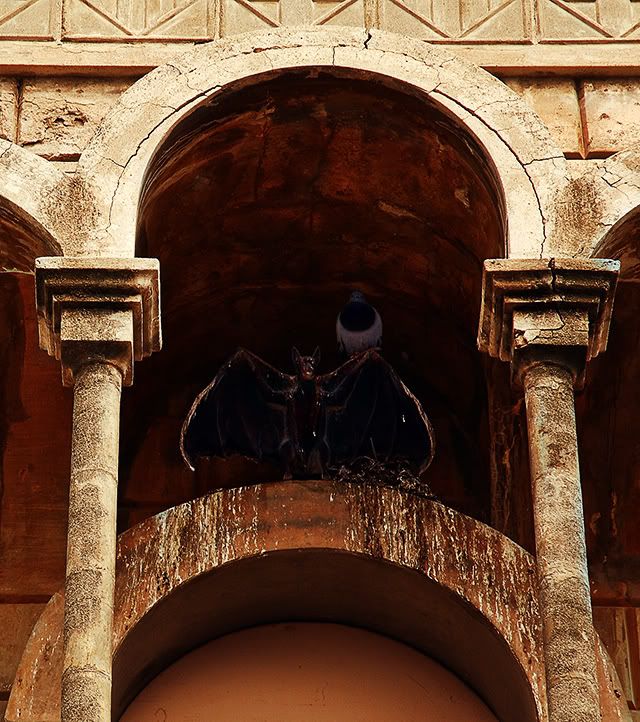
This is a bat, a symbol that was part of Güell family's coat of arms, and on top the omnipresent pigeon, that seems to be some sort of evil partner watching me from his master's shoulder, sorry, wings. She may not harm anyone but she did cover the historic figure with all her glorious s***. The house, belonged to Colonia Guell's secretary (remember Colonia Guell was an industrial estate in Santa Coloma de Cervelló, near Barcelona). It was founded by Eusebi Güell i Bacigalupi in 1890. Güell was a wealthy man and his wife Isabel López Bru, was the daughter of Antoni López i López, first Marques of Comillas who was also a very rich man. Güell ran important textile factories in Barcelona but those were hard times for the sector. To be competitive, especially with the British industry, workers had to produce more for the same money or less. So people started to get organized and to claim for their rights and Güell decided to build a better place out of the city where workers could live around the factory and integrate themselves more in the company. He managed to do so for some time but trade unions and their claims arrived to Colonia Güell in the end.
April 24, 2008
Rats at Exotic Animals Stall in Las Ramblas, Barcelona
Some baby rats at exotic animal stall in Las Ramblas, Barcelona. As I am no expert and I can't tell a rat from a mouse I leave you a link about these rodents' morphology: Rats and Mice: Differences. Of course the study of animals is not the purpose of this blog. The rats were in Barcelona and they happened to make a perfect pack.
April 23, 2008
Barcelona, Gothic Quarter: Casa de los Canónigos at Bisbe Irurita Street

Casa de los Canónigos o Casa dels Canonges (Canons' House) at Bisbe Irurita street and next to Sant Jaume square is a XIV c. Gothic building restored in the 1920s by Rubió i Bellver and Jeroni Martorell. It was then that neogothic elements were added to the original building like this bridge connecting Palau de la Generalitat premises with the above mentioned religious house that until 1980 used to be the Official Residence of the President of La Generalitat. Jordi Pujol, the first elected Catalan government president after the 1978 Constitution discarded the house as private residence and so have done his successors.
April 22, 2008
Vildsvin, The Old Tavern in Ferran Street, Barcelona
![Vildsvin, The Old Tavern in Ferran Street, Barcelona [enlarge]](https://i63.photobucket.com/albums/h135/carloslorenzo/Vildsvin_The_Old_Taverna_.jpg)
Vildsvin, The Old Tavern (L'Antiga Taverna), 38 Ferran, Barcelona. It is funny to use a Swedish word to baptize the stylish but informal middle European tavern conceived by Sagardi Euskal Taberna Group. If you are reading this you know English, so Vildsvin might ring a bell. Let's see in German: Wildschwein. Huh, do you get it now? Wild Swine? Ok, let's quit it. That's a wild boar. Would you believe that a cute, chic place, with tiled floor, noble wood furniture and an oyster bar in the ground floor is called the Wild Boar? Nope. So I can imagine some smart guy, saying hey, it has to be a wild boar cause a tavern is a tavern but we are going to make it sound a little posh so we create an atmosphere here.
April 21, 2008
Bubblebou Show by Pep Bou - Port Aventura Amusement Park, Salou

Welcome to Bubblebou, that is, one of the bubble shows created by Pep Bou, a unique artist when it comes to creating magical shapes out of common and ephemeral soap bubbles.
The first of my three day stay at hotel El Paso in Port Aventura amusement park (Salou, Tarragona) it was raining cats and dogs so we had to spend our time in indoor shows. Lucky us! My wife told me we were going to the Chinese pavilion to see something called Bubblebou. No idea. There we were, an off voice was reminding us about the usual "don'ts". No food, no cell phones, no nothing...but thanks God they said they just excluded flashes and spared cameras.
So there I went, shooting like mad. Thanks to that I can share this tender moment with you: A girl from the audience, covered by a gargantuan multicolor bubble and the artist, satisfied by his evanescent creation.
Here is a link to Pep Bou's homepage (I couldn't find the name of the man in my photograph who obviously is not Pep but is part of his artistic group).
April 20, 2008
Magic Bubblebou Show at Port Aventura Amusement Park: Silhouette
 |
| Silhouette of a Man Holding Bubble |
And now for a totally different picture, ladies and gentlemen I would like to introduce tonight the Bubblebou Show. No, it is not about Chinese silhouettes although it takes place in the China area of Port Aventura Amusement Park.
It is all about bubbles, huge bubbles of impossible shapes that this man behind the screen tames with dexterous and exquisite talent. Please come back tomorrow to know more about Bubblebou and its creator, Pep Bou, the master of bubbles.
![Narrow Alley [enlarge]](https://i63.photobucket.com/albums/h135/carloslorenzo/NarrowAlley_.jpg)
